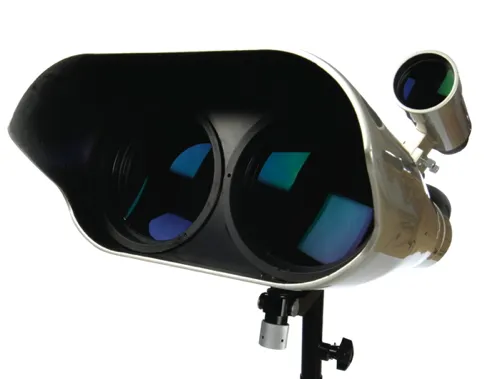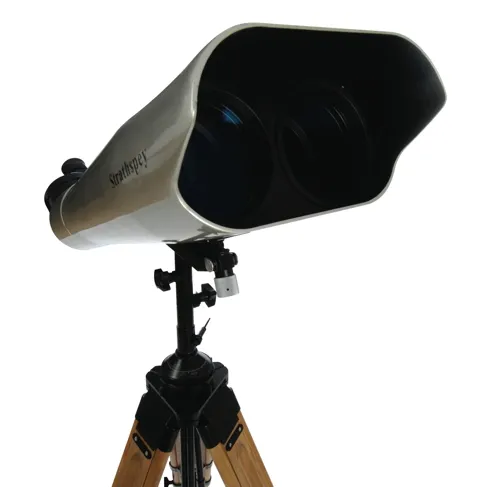Price: £1500.00
Aperture: 120mm
Focal Length: 720mm
Eyepieces: 30x and 50x
Mount: Adjustable hardwood tripod
Weight: 18.3kg (binoculars) + 7.3kg (tripod)
Supplier: Strathspey
Telephone: 01479 812549
Website: www.strathspey.co.uk
Back in the days of yore, when astronomers used their own eyes rather than cameras to make new discoveries, giant binoculars like the Strathspey 120mm were a comet sweeper’s instrument of choice.
The combination of wide fields of view, decent apertures, the ability to use both eyes and a comfortable 45° viewing angle is hard to beat for enjoying the night sky.
These giant binoculars come with two sets of eyepieces whose focal lengths give 30x and 50x magnification.

They have exit pupils of 4mm and 2.4mm respectively – small enough to fit even into the pupils of a middle-aged person’s dark-adapted eyes.
A third, narrower-diameter eyepiece set is also included, for reasons we will come to shortly.
At the time of our test, a fork mount was not yet available for these 120mm monsters and so a single, slightly shaky, hinged altaz arrangement was supplied.
This prevents the binoculars reaching the zenith but is just a temporary mounting.
A beefier fork mount should be made available from Strathspey early in 2008.
Big is beautiful
Assembling these binos on their simple altaz tripod mount was easy.
The instruments have a Cold War-era military feel to them. At 18kg (40lb) they are very heavy, and the housing is slippery with no handle to grab hold of.
You would not want to grapple with such a slippery mass in the dark without an assistant.
Once seated comfortably, the view through them was marvellous; the rich Milky Way star fields were particularly stunning.
You’ll really feel as if you are immersed among our Galaxy’s stars, thanks to the apparent field of view of roughly 65° from both the 30x and 50x eyepieces.
This translated to a true field on the sky of 2.2° and 1.3˚ respectively.
The Andromeda Galaxy nicely filled the low-power view on a crystal clear, dark Moon-less night.
We were lucky enough to get hold of these instruments a few days before Comet 17P/Holmes went into outburst, and they proved to be the ideal bit of kit for this object.
Optically, the field was sharp in the centre, but rapidly deteriorated towards the field edge.
These aren’t apochromats, but they are of a high enough quality for medium-power viewing.
The 7x50 finder was useful here: it gives a 6° field, although it can’t be adjusted and is a straight-through design.
The only downside to these otherwise very enjoyable huge binoculars is viewing comfort if your eyes are too close together.
The interpupillary distance on these binoculars ranges from 58 to 89mm.
According to the Dictionary of Optometry and Visual Science, in Europe 90 per cent of adult men have interpupillary distances between 57 and 69mm; most adult women have distances between 52 and 64mm.
So for some men, many women and all children, the eyepieces on these binoculars will be too far apart.

The Comfort Factor
Astronomers know that they must often resign themselves to some discomfort while observing.
To reach the eyepiece, you may have to balance precariously on a stepladder or crouch down at a neck-cricking angle.
Handheld binoculars avoid this problem, but then your arms start aching and shaking after a few minutes.
In addition, many binoculars simply don’t offer enough aperture to see faint objects.
Large binoculars with a 45° eyepiece viewing angle get around all of these problems.
You don’t have to pull contortions to get to the eyepiece, there is plenty of light grasp, and you can sweep around for hours seeing the sky the right way up.
The addition of stereo viewing is kinder on the brain, too.
It gives the sky a 3D quality.
In the 1950s and 1960s, large binoculars were used by Czech observers and the UK’s George Alcock to discover many comets.
It was, quite simply, the only way to make sweeping the sky for hours on end tolerable, because the 45°-angled eyepieces meant that any altitude could be viewed in absolute comfort.
A bridge too far
There is another problem: at 57mm in diameter, the eyepiece barrels are quite big and leave no room for your nose if it happens to be on the large side.
That’s unless your eyes are quite far apart.
This will be a major issue for some people.
To get around this, Strathspey provides a third eyepiece option, in addition to the two we’ve already mentioned.
This is a narrow-barrel set of 15mm focal length, which accomodates large noses better.
They gave about 48x magnification.
It should be pointed out that both the wide- and narrow-barrel eyepieces are push fit and are intended for these binoculars’ non-standard 37mm diameter eyepiece holder.
We did get hold of a pair of converters to narrow the 37mm eyepiece holders down to the standard 1.25-inch (31.7mm) diameter of most eyepieces, but one of these was too small.
It had a 31.6mm hole, so it wouldn’t accept a standard astronomy eyepiece.
Unless, of course, said eyepiece had also been accidentally manufactured a bit narrower than normal.
The ability to get the most out of these binoculars depends to some degree on your physical features but, if they fit your face – wear them!
They will give you fantastic wide-field views that will suddenly make lugging these 18kg instruments around well worth the effort.